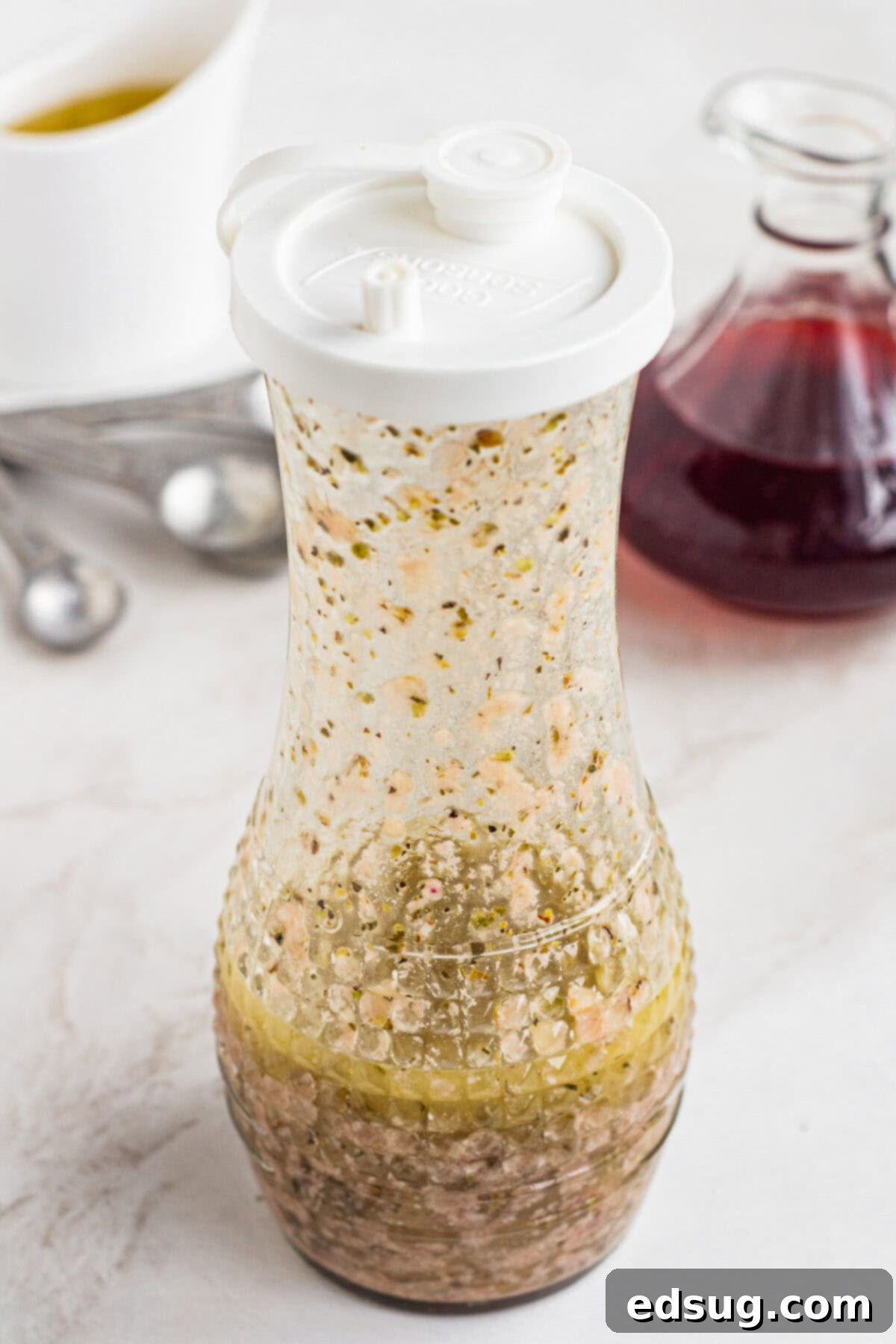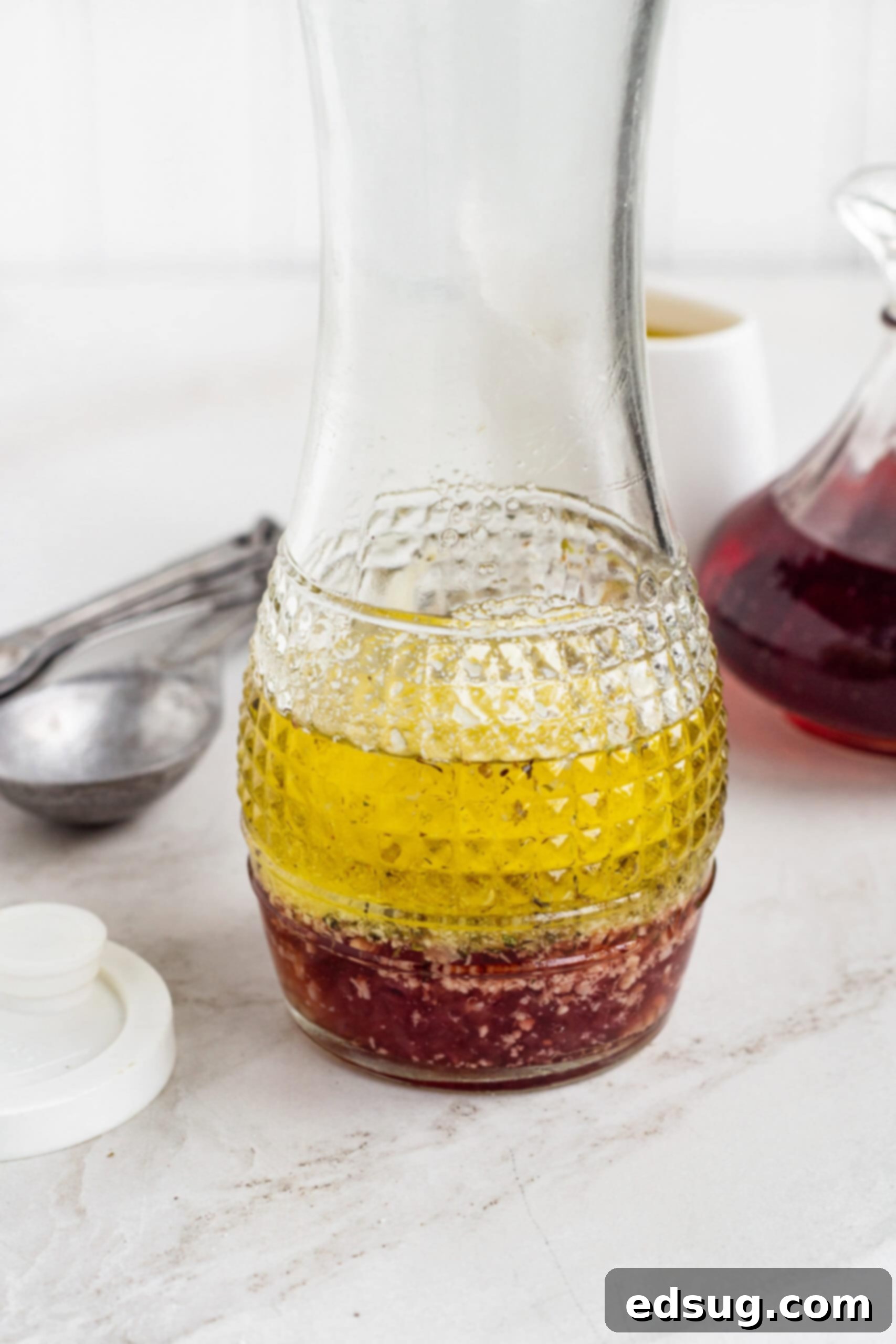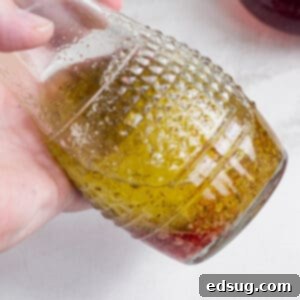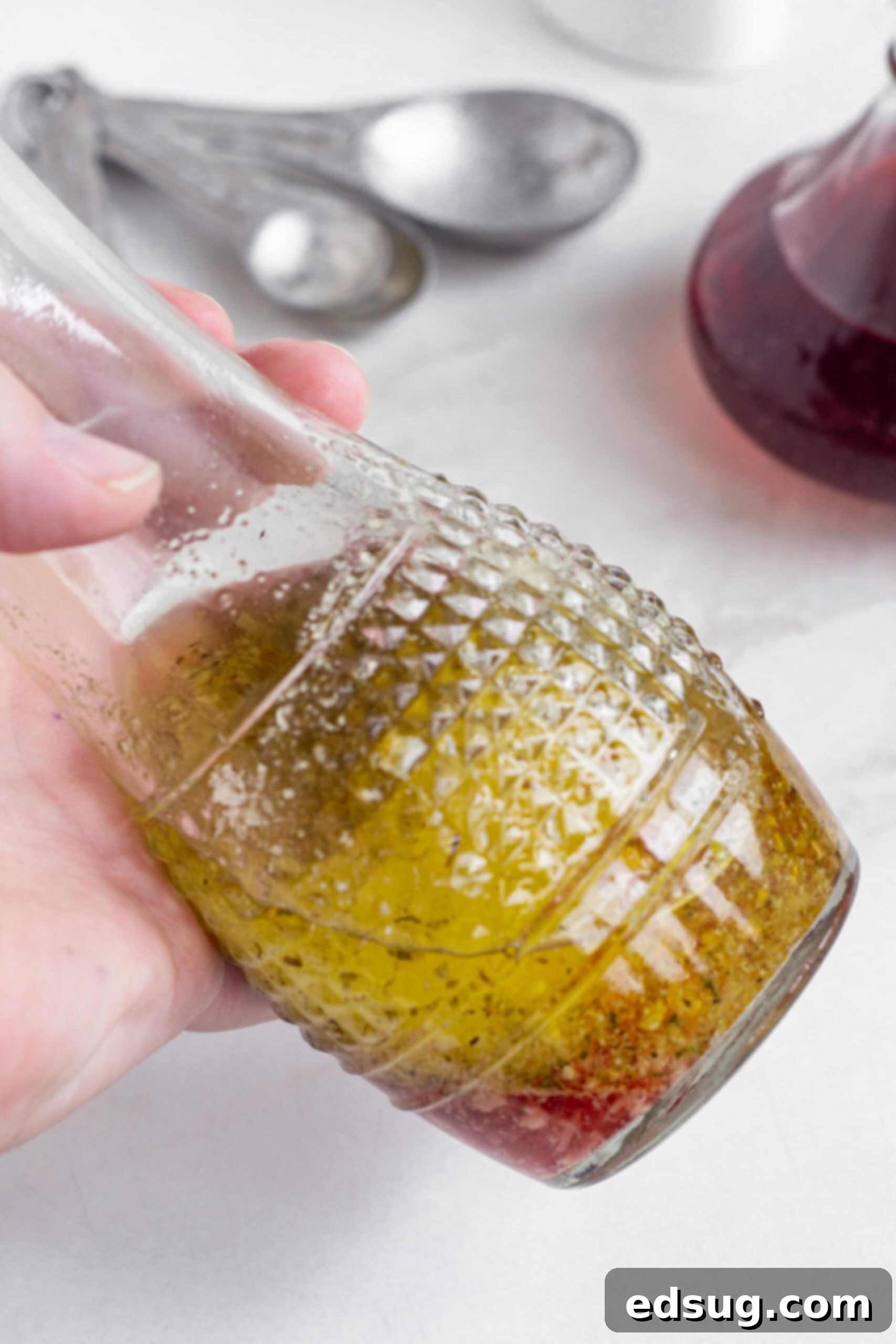Homemade Red Wine Vinaigrette: Your Ultimate Guide to a Zesty & Versatile Dressing
Say goodbye to bland, store-bought salad dressings! This homemade red wine vinaigrette is a game-changer, crafted with just a handful of simple, wholesome ingredients like quality olive oil, vibrant red wine vinegar, and aromatic herbs. It’s an incredibly versatile dressing that adds a zesty, fresh burst of flavor to everything from crisp salads and hearty sandwiches to savory marinades. Once you experience the unparalleled taste and ease of this recipe, you’ll wonder why you ever bought it from the store!
I frequently use this delightful red wine vinaigrette to elevate my Italian subs, where its bright and tangy notes perfectly cut through the richness of the meats and cheeses. Its quick preparation and incredible versatility led me to believe it truly deserved a dedicated spotlight. This recipe isn’t just a dressing; it’s a culinary staple that will transform your everyday meals.

Table of Contents
- Why You’ll Love This Homemade Red Wine Vinaigrette
- Essential Ingredients for Red Wine Vinaigrette
- Step-by-Step Guide: How to Make Red Wine Vinaigrette
- Customizing Your Homemade Vinaigrette
- Frequently Asked Questions About Vinaigrettes
- Creative Ways to Use Red Wine Vinaigrette
- Storing Your Homemade Red Wine Vinaigrette
- More Delicious Homemade Salad Dressings
- Red Wine Vinaigrette Recipe Card
Before you even think about reaching for that bottle of commercial salad dressing, take a moment to check your pantry! There’s simply no comparison to the vibrant freshness and exquisite flavor of a homemade red wine vinaigrette. Crafted with high-quality olive oil, perfectly balanced red wine vinegar, and a thoughtful combination of fresh and dried herbs, it delivers an authentic taste that store-bought versions can only dream of. Vinaigrettes are renowned for being among the simplest dressings to prepare from scratch, and the best part is, you likely already have most of the necessary ingredients readily available in your kitchen. Embrace the art of homemade and elevate your meals effortlessly!
Why You’ll Love This Homemade Red Wine Vinaigrette
This red wine vinaigrette recipe isn’t just easy; it’s a culinary revelation that will quickly become a cherished staple in your home. Here’s why it stands out:
- Incredibly Quick to Prepare. One of the greatest joys of cooking is transforming basic pantry ingredients into something extraordinary, and this vinaigrette does just that in minutes. Forget complicated steps or lengthy processes; simply gather your ingredients, add them to a jar, and shake vigorously. You can literally whip up this vibrant dressing in less than five minutes, making it perfect for busy weeknights or impromptu gatherings. It’s ready to use immediately, or you can store it in the fridge for later enjoyment.
- Bursting with Fresh, Authentic Flavors. Even the most highly-rated store-bought dressings often fall short when compared to the deep, nuanced flavors of a truly homemade vinaigrette. This recipe features the unmistakable zest of fresh onion and garlic, complemented by the savory depth of Parmesan cheese. These fresh components are impossible to replicate in bottled dressings, delivering an unparalleled taste experience that will make your salads and dishes sing.
- Remarkably Versatile. Beyond its primary role as a stellar salad dressing, this red wine vinaigrette boasts an impressive versatility that will surprise and delight you. It keeps beautifully in the fridge for weeks, ensuring you always have a flavorful enhancer on hand. Use it to dress a simple tossed salad, invigorate lightened-up pasta salads, or add a tangy kick to your favorite sandwiches. I even love to drizzle it over crusty bread, using it in place of a traditional bread dipping oil, especially when served with warm garlic breadsticks! It’s also fantastic as a marinade for chicken or vegetables, adding a bright, acidic lift to any meal.

Essential Ingredients for Red Wine Vinaigrette
While the classic French “formula” for a basic vinaigrette often suggests a ratio of 1 part vinegar to 3 parts oil, I personally find that my red wine vinaigrette shines brightest with a bolder, zestier profile. Therefore, I prefer a closer-to-equal ratio, often going for half and half. Ultimately, the perfect balance is up to your personal taste. Below, I’ll detail the key ingredients you’ll need, along with tips for selection and potential substitutions. For the precise measurements, please refer to the printable recipe card provided further down the page.
- High-Quality Olive Oil – This is the foundation of any good vinaigrette. Extra virgin olive oil offers the richest, most complex flavor that truly elevates your dressing. Look for cold-pressed varieties for the best taste. If olive oil isn’t your preference or you need an alternative, avocado oil is an excellent close second, providing a smooth texture and neutral flavor profile.
- Red Wine Vinegar – Our star ingredient and the namesake of this dressing! The quality of your red wine vinegar profoundly impacts the final flavor. Invest in a good brand for a truly superior vinaigrette. A wonderful aspect of this recipe is its adaptability; you can easily swap red wine vinegar for other vinegars like white wine vinegar for a milder tang, balsamic vinegar for a sweeter, richer dressing, or apple cider vinegar to create a delightful apple cider vinaigrette. Each substitution will lend a unique character to your dressing.
- Fresh Red Onion – I recommend finely grating the red onion to ensure its pungent flavor is evenly distributed without overwhelming the dressing with large chunks. This method also helps to release its juices, enhancing the vinaigrette’s depth. Alternatively, you can finely dice it if you prefer a bit more texture. If red onion isn’t available, a sweet Vidalia onion makes a great substitute, offering a milder, sweeter onion note.
- Parmesan Cheese – Freshly grated Parmesan or Pecorino Romano cheese is highly recommended for its intense, salty, and umami-rich flavor, which melts beautifully into the dressing. However, if convenience is key, pre-grated Parmesan can be used, though it may not incorporate as smoothly or offer the same depth of flavor.
- Fresh Garlic – Minced fresh garlic is essential for that unmistakable aromatic kick. For an even more integrated flavor, you can grate the garlic alongside the onion. For an added layer of rich, mellow flavor, consider roasting the garlic before mincing it. This process sweetens the garlic and removes any harshness, adding incredible depth to your vinaigrette.
- Dried Oregano – This classic Mediterranean herb brings a warm, earthy, and slightly bitter note that complements the other ingredients beautifully. In addition to oregano, don’t forget the essential seasonings of salt and freshly ground black pepper to taste. These pantry staples enhance and balance all the flavors in the dressing. For an extra touch, you could experiment with a pinch of dried basil or a touch of red pepper flakes for a subtle warmth.
- Salt and Black Pepper – These are non-negotiable for seasoning. Always taste and adjust to your preference. Freshly cracked black pepper offers a more potent aroma and flavor compared to pre-ground.
Step-by-Step Guide: How to Make Red Wine Vinaigrette
Making your own homemade red wine vinaigrette is astonishingly simple, requiring just two straightforward steps that anyone can master:


- Step 1: Combine All Ingredients. Begin by adding your olive oil, red wine vinegar, grated red onion, grated Parmesan cheese, minced garlic, dried oregano, salt, and black pepper into a clean, airtight glass jar. A jar with a tight-fitting lid is ideal for both mixing and storing, ensuring minimal mess and maximum convenience.
- Step 2: Emulsify with a Shake. Once all ingredients are in the jar, securely seal the lid. Now, give the jar a vigorous shake for about 30-60 seconds. This energetic shaking action is crucial for emulsifying the vinaigrette, meaning it blends the oil and vinegar into a smooth, cohesive, and slightly thickened dressing rather than letting them remain separated. This creates a creamy texture that adheres better to your food.
Alternatively, if you don’t have a jar, you can achieve the same emulsification by vigorously whisking the dressing in a bowl. Pour the oil in slowly while continuously whisking the vinegar and other ingredients. This continuous motion helps to break down the oil into tiny droplets, allowing it to suspend evenly throughout the vinegar base. Your freshly made vinaigrette is now ready to transform your meals. You can serve it immediately or store it in the fridge for future use. For detailed storage instructions, please refer to the dedicated section further below.

Customizing Your Homemade Vinaigrette
One of the best things about making dressings from scratch is the freedom to customize. Don’t be afraid to experiment with these ideas:
- Herb Variations: While dried oregano is fantastic, feel free to try other dried Italian herbs like basil, thyme, or a blend. For an even fresher taste, substitute dried herbs with fresh ones (usually a 3:1 ratio of fresh to dried). Fresh parsley or chives, finely chopped, can add an extra layer of flavor and color.
- Sweetness Balance: If your vinaigrette tastes too sharp or acidic, a tiny touch of sweetness can balance it beautifully. A pinch of sugar, a swirl of honey, or a dab of maple syrup can mellow the tanginess of the vinegar. Start with ¼ teaspoon and add more to taste.
- Spice It Up: For those who enjoy a little heat, a pinch of red pepper flakes can provide a subtle warmth that enhances the overall flavor profile without overpowering it.
- Mustard for Extra Emulsification: As mentioned in the FAQ, Dijon mustard isn’t just for thickening; it also acts as a powerful emulsifier. Even a small amount can help keep your oil and vinegar perfectly blended, adding a savory, tangy note at the same time.
Frequently Asked Questions About Vinaigrettes
Absolutely! While vinaigrettes are traditionally known for being thinner and lighter than creamy dressings like ranch, you can certainly thicken this red wine vinaigrette to your preferred consistency. For a slightly creamier texture, try adding about a teaspoon of Dijon mustard. Dijon acts as a natural emulsifier and thickener without significantly altering the flavor. Alternatively, a small amount of mayonnaise or plain Greek yogurt can also create a richer, creamier version, reminiscent of my creamy balsamic dressing recipe. Experiment with small additions until you reach your desired thickness.
A bitter taste in your homemade vinaigrette is often a sign of old or oxidized ingredients. The primary culprits are usually olive oil or vinegar that are past their prime. When these ingredients degrade, they can develop an unpleasant bitter flavor. To remedy this, first and foremost, always use fresh, high-quality ingredients. If your current batch tastes bitter, you can attempt to salvage it by adding a small amount of honey or a pinch of sugar, which can help to balance the bitterness. However, for the best possible flavor and to prevent future bitterness, I strongly recommend checking the expiration dates of your oil and vinegar and investing in fresh supplies. Sometimes, too much raw garlic or onion can also contribute to a sharp, bitter note; if this is the case, consider reducing the amount or mellowing them slightly (e.g., by roasting garlic).
Emulsification is crucial because oil and vinegar naturally separate. By vigorously shaking or whisking, you break the oil into tiny droplets that become suspended within the vinegar, creating a stable, smooth, and cohesive dressing. An emulsified vinaigrette coats food more evenly, delivers a consistent flavor in every bite, and has a more appealing texture. Without proper emulsification, your dressing will be thin and watery, with oil and vinegar pooling separately.
Absolutely! Using fresh herbs will impart an even brighter, more vibrant flavor to your red wine vinaigrette. As a general rule of thumb, you’ll need three times the amount of fresh herbs compared to dried herbs. For example, if the recipe calls for 1 teaspoon of dried oregano, use 3 teaspoons (or 1 tablespoon) of fresh, finely chopped oregano. Fresh parsley, basil, or a mix of Italian herbs would also be wonderful additions.

Creative Ways to Use Red Wine Vinaigrette
Red wine vinaigrette is far too delicious and versatile to be confined solely to salads! The more I explore this simple recipe, the more innovative uses I discover. Beyond traditional applications, this zesty dressing can truly elevate a multitude of dishes. Here are some of my favorite creative ideas to inspire you:
- Elevate Green Salads. This easy red wine vinaigrette is a fantastic choice for almost any green salad, but it truly shines on robust and flavorful options. I particularly adore it on my antipasto salad and grinder salad recipes. The bright tanginess of the dressing provides a perfect counterpoint to the rich, savory flavors of deli meats like salami, ham, and pepperoni, creating a beautifully balanced bite.
- Brighten Other Salads. Don’t limit yourself to just green salads! This vinaigrette is an excellent way to add a refreshing zing to various pasta and grain salads. Try it with a Mediterranean pasta salad, a light and fresh orzo pasta salad, or as a light, flavorful dressing for a roasted potato salad with caramelized onions and bacon or a vibrant quinoa salad. It adds a lovely acidity that can cut through the starchiness of potatoes or grains.
- Transform Sandwiches and Wraps. Infuse a zesty flavor into your sandwiches and wraps by brushing or drizzling this vinaigrette over the bread or fillings. It’s particularly amazing on pinwheel sandwiches, giving them an unexpected pop, or on a classic turkey club for an extra layer of moisture and tang. It can also be mixed into tuna salad or chicken salad for a vibrant twist.
- Enhance Appetizers. Take your appetizers to the next level. Use this versatile vinaigrette to marinate diced tomatoes for classic bruschetta, infusing them with garlic and herb goodness. Alternatively, serve it alongside a platter of crusty bread and garlic bread as a sophisticated dipping oil for a simple yet elegant starter.
- Marinade for Meats and Vegetables. The acidity of red wine vinegar makes this vinaigrette an excellent marinade. Use it to tenderize and flavor chicken, pork, or even firm fish before grilling or baking. It also works wonders as a quick marinade for vegetables like bell peppers, zucchini, or mushrooms before roasting them.
- Drizzle for Roasted Vegetables. After roasting vegetables like asparagus, broccoli, or Brussels sprouts, a drizzle of this red wine vinaigrette can add a bright, acidic finish that enhances their natural sweetness and char.

Storing Your Homemade Red Wine Vinaigrette
Proper storage is key to enjoying your delicious homemade red wine vinaigrette for an extended period. When stored in an airtight container – ideally the same jar you used to mix it – this vinaigrette will last beautifully in the fridge for up to 2 weeks. Over time, the flavors will meld and intensify, often becoming even more delicious after a day or two. It’s important to remember that the oil and vinegar may separate when chilled, which is completely normal. Simply give the container a good shake or a quick whisk before each use to re-emulsify the dressing and ensure a consistent, flavorful application.
More Delicious Homemade Salad Dressings
If you’ve enjoyed making this red wine vinaigrette, you’ll love exploring other homemade dressing recipes. They’re often healthier, fresher, and more flavorful than anything you can buy at the store. Here are some of my other favorites:
- Zesty Lemon Garlic Vinaigrette
- Authentic Greek Vinaigrette
- Rich Roasted Garlic Vinaigrette
- Creamy Avocado Dressing
- Classic Thousand Island Dressing

Homemade Red Wine Vinaigrette
Ingredients
- ¼ cup extra virgin olive oil
- ¼ cup red wine vinegar
- 1 tablespoon red onion, finely grated
- 1 tablespoon freshly grated Parmesan cheese
- 2 teaspoons fresh garlic, minced (or grated)
- 1 teaspoon dried oregano
- ¼ teaspoon salt
- ⅛ teaspoon black pepper, freshly ground preferred
Instructions
- In a glass jar with a tight-fitting lid, combine the olive oil, red wine vinegar, grated red onion, grated Parmesan cheese, minced garlic, dried oregano, salt, and black pepper.¼ cup olive oil, ¼ cup red wine vinegar, 1 tablespoon red onion, 1 tablespoon grated Parmesan cheese, 2 teaspoons garlic, ¼ teaspoon salt, ⅛ teaspoon black pepper, 1 teaspoon dried oregano
- Secure the lid tightly and shake the jar vigorously for 30-60 seconds until all ingredients are well combined and the vinaigrette is emulsified (thickened and uniform).
- Taste the dressing and add additional salt and pepper as needed to suit your preference. Serve immediately or store in the refrigerator.
Notes
- This versatile vinaigrette is perfect for my Italian subs and is utterly delicious on salads, sandwiches, and as a marinade for various dishes.
- For a creamier texture, you can add 1 teaspoon of Dijon mustard or a tablespoon of mayonnaise when mixing.
- If the dressing separates during storage, simply shake it well before using again.
Nutrition Information
Nutrition information is automatically calculated, so should only be used as an approximation.
Additional Recipe Info
I’ve created a fun and engaging group on Facebook, and I would absolutely love for you to join us! It’s a vibrant community where you can share YOUR favorite recipes, ask questions, get cooking inspiration, and stay up-to-date with all the latest from Dinners, Dishes and Desserts (so you never miss out on a delicious new recipe)!
Be sure to follow me on Instagram and tag #dinnersdishes so I can see all the wonderful DINNERS, DISHES, AND DESSERTS recipes YOU create!
Make sure to follow me on my social media channels, so you never miss a post!
Facebook | Twitter | Pinterest | Instagram
.
